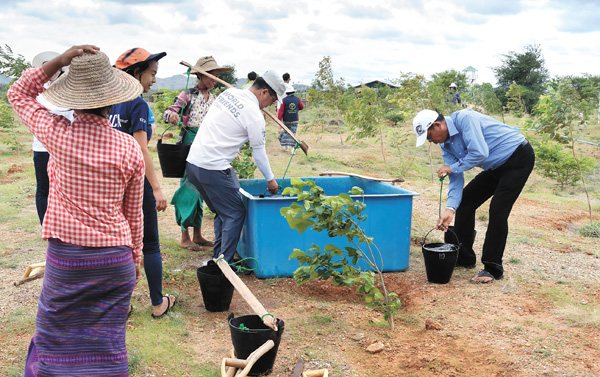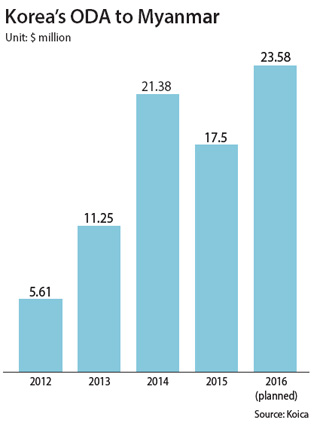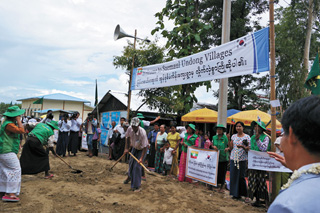Korean project battles desertification in Myanmar

Korean volunteers and local villagers draw water from a tank on June 9 as they plant trees in the dry Bagan region as part of Koica’s ongoing long-term forestation project in Myanmar to combat climate change and desertification in the area. [SARAH KIM]
Most of the villagers make their living by farming fruits and vegetables or raising livestock, making the local land degradation an existential threat.
So for villagers like 19-year-old Hnin Hnin Yu, the forestation project helmed by the Korea International Cooperation Agency (Koica) has been a boon both for the long-term development of the region and for their immediate survival.
“We live in a dry zone,” the teenage girl says, “so after planting trees we have more grass, and villagers say it rains more frequently, plus we now have more feed for our goats and cows.”
Since 1998, Koica, a grant aid agency under Korea’s Ministry of Foreign Affairs, has led a forest management project in Myanmar planting some 900,000 trees across 840 hectares, an area equivalent to roughly 1,200 football stadiums.
The effect of desertification in a region known for ancient temples and celestial sunsets makes for a severe contrast at the forestation project site.
The fenced area is lush and green where new trees have been planted over the past several years, but just a few steps away, the soil turns into sand and the trees give way to an open expanse sparsely dotted with a handful of palm trees.
Hnin Hnin Yu, dressed in a traditional longyi and straw hat, is among a dozen young women from nearby villages who were there to help out at Koica’s forest management site in Bagan on June 9, working alongside Korean volunteers to plant neem tree saplings.
In addition to planting trees, Koica has also distributed 6,000 new cooking stoves, or hwadeok, to 20 villages in the area in order to decrease the amount of lumber households use.
“Our family received a new cooking stove from Koica,” says 27-year-old volunteer Tin Tin Hla, who comes from a family of 10. “It’s much more convenient to use, and it cuts down wood usage by about half.”
But perhaps most importantly, after 18 years of joint forestation efforts, locals have learned the importance of conservation. According to the UN Food and Agricultural Organization (FAO), between 2010 and 2015, Myanmar lost more than 546,000 hectares of forest each year, making the country the third worst in the world for deforestation.

“The forest management project first began in 1998 when Koica wanted to convey Korea’s tree-planting technology to Myanmar, and Korea sent in our experts to begin the first phase,” says Koica’s Myanmar office head, Nam Kwon-hyoung.
“This expanded to the second phase in 2004 and the third phase in 2008. We are now finishing up the fourth phase. This was possible through the active participation of villagers here, the Myanmar Forestry Ministry and other supporters.”
But the forest management project is just one of many aid projects led by the Korean government to support Myanmar. Other projects focus on rural development and the sharing of agricultural technology.
With the easing of sanctions on Myanmar in 2012, the amount of official development assistance the Korean government has offered the Southeast Asian country has increased fourfold. Between 1991 and 2015, Koica has provided a total of $89.57 million in official development assistance (ODA) to Myanmar.
Koica, which was founded in 1991, opened its Myanmar office in 2001, which currently has 35 members.
The Korean government last year selected Myanmar as a new priority ODA partner country, and by the end of this year, Koica plans to funnel $23.58 million into various projects in Myanmar. It is currently running 12 projects with 88 volunteers and training some 200 people.
Other key projects include community leadership programs, farmland consolidation and agricultural machinery training, the development of inland fish-farming technology and law enforcement coordination.
By 2019, Koica also plans to construct the Myanmar Development Institute, modeled after the Korea Development Institute, in the capital city of Naypyidaw.
Ba Kaung, a planning director with Myanmar’s Ministry of Environmental Conservation and Forestry, has been involved in the forestation project for over a decade and says that planting trees requires patience, but it has numerous “intangible benefits.”
“Because forests in the central region are severely damaged and environmental and weather conditions are severe with high temperatures and low rainfall, this is an important investment for us,” he says.
The highest summertime temperature in Myanmar is usually 40 degrees Celsius (104 degrees Fahrenheit), but in recent years, it has risen as high as 45 degrees.
Furthermore, the wet season, which generally starts from mid-May going through to October, has decreased over the past 30 years by 40 days. In 1978, the wet season was 145 days long, but in 2010, it lasted only 105 days.
The environmental official also pointed out that because of the effects of El Nino, Myanmar’s summer season has been especially hot this year and the heat lasted a month longer than usual.
While this did not hinder the planting of trees, it had a big impact on the villagers’ farming activities, he pointed out.
The first phase saw 72,900 trees planted across 120 hectares of land from 1998 to 2000, the second phase saw 163,614 trees planted across 330 hectares from 2004 to 2005, and the third phase had 55,238 trees planted across 150 hectares from 2008 to 2010.
Korea invested $180,000 in the first phase, during which it mainly provided equipment and expertise. But through trial and error, the later phases were expanded. The second phase saw $300,000 and then $1.5 million for the third.
The current stage of the Myanmar forest management capacity-building project, the fourth phase, kicked off in 2014 with a budget of $2.3 million, and it will see 150,000 trees planted across 240 hectares of land by September.
Eight types of trees that generally require less water to grow are planted in the fourth phase, the most common being eucalyptus and fast-growing neem trees.
But the long-term project has also faced setbacks, especially when it first started out about 18 years ago.
“At that time, we didn’t think too much about community participation and we didn’t have environmental education,” Ba Kaung says. “So the people afterward simply cut down the trees for fuel wood or animal feeding.”
Thus, starting with the second phase, they incorporated education of villagers into the program.
“That is why we included other portions like environmental education and water resource development,” he says, “so that people understand this is good for them in the long run.
The project also receives support from the Green Asia Network, a Seoul-based nonprofit organization.
“Out of our ODA projects, planting trees is especially eco-friendly and promotes sustainable development as a means to combat ongoing climate change and desertification,” says Moon Sang-won, senior deputy representative at Koica’s Myanmar office. “It is a means of giving back to Myanmar what we have gained in the past.”

The people of Kanthar, one of the 100 villages in Myanmar selected to take part in a rural development project modeled after Korea’s Saemaul (New Village) Movement, welcome the arrival of a delegation of Koica volunteers on June 7. [SARAH KIM]
While one part of Myanmar suffers droughts, other regions have to cope with flooding.
On June 7, villagers from Kyauncone in Naypyidaw are hard at work digging a trench alongside a dirt road to drain rainwater amid a shower during monsoon season.
Kyauncone is one of about 40 villages located in Myanmar’s capital that are designated to take part in the $22 million Saemaul Movement project launched in 2014 to 2019, and it is seeing a boom in community cooperation and working on building basic infrastructure.
Korea’s Saemaul Movement project, also known as the New Village Movement, helps rural communities guide their own development. It was originally an initiative by former President Park Chung Hee in the 1970s to develop and modernize rural villages.
Myanmar has designated 100 model villages to take part in the Saemaul-style rural development project.
Each village initially received $20,000, but subsequent aid will be granted on a merit-based system following an evaluation process.
“For the first time, we have had other villagers coming to our village to see how the project unfolds, and we are developing contacts outside our village,” says Nyunt Shwe, chairman of the Saemaul Movement Committee of Kanthar Village. “We have worked on building roads, and our livelihood is improving.”
Kanthar, which neighbors Kyauncone, is a low-income rural village of just 387 people forming 95 households.
The village dates back to 2006, when the capital of Myanmar moved to Naypyidaw, resulting in the relocation of many landless farmers.
Aspects of Myanmar’s past resemble that of Korea, including colonial rule and a military dictatorship. Koreans are quick to point out that the Southeast Asian country resembles that of a pre-industrialized Korea in the 1960s.
But Myanmar is around 3.5 times larger than the Korean Peninsula and is lush with natural resources.
Over half a century ago, Myanmar was a leading exporter of rice, far more prosperous than Korea, a country that was poor and torn apart following the 1950-53 Korean War. Myanmar was rightfully called the “rice bowl of Asia” but became impoverished under the rule of a military junta lasting from 1962 to 2011.
Since 2011, when a quasi-civilian government took power, Myanmar has seen an impressive annual growth rate of over 7 percent, according to the World Bank.
Washington rolled back on sanctions the following year, allowing U.S. investment in Myanmar in support of the political and economic reforms taking place in the country.
And in November 2015, the National League for Democracy (NLD) won a milestone election with the victory of the country’s first civilian government in decades, led by democratic champion Aung San Suu Kyi, now Myanmar’s state counselor.
But the gross domestic product per capita in Myanmar remains around $1,300, according to Koica’s Myanmar Office.
“With the spirit and active participation of our people, I believe that the Saemaul Movement can succeed here as it has in Korea,” says Tin Htut, permanent secretary of the Ministry of Agriculture and Irrigation.
Hallyu, or the Korean Wave, has hit Myanmar, and Korean dramas are especially popular, aired daily across television channels throughout the country.
The permanent secretary says his recent favorite Korean drama is “Reply 1988,” the megahit 2015 cable television series.
“Myanmar is not even like Korea was in 1988,” he says, judging from the retro-themed drama of what Korean family life was like in the late 1980s. “But the Saemaul Movement will play a role in transitioning Myanmar from poverty to prosperity.
“Myanmar is like a boat, wanting to sail faster and faster, but right now our sail is full of holes,” he says. “For us, Korea is like the mast.”
Roughly 70 percent of the country is farmland, and the agricultural industry accounts for nearly one-third of its GDP and 23 percent of its exports. Therefore, agricultural development is a key part of Myanmar’s future.
“I think the most important thing for our country is not just capital but the infusion of … new technology in the agricultural sector,” Han Tha Myint, who chairs the NLD’s economic committee and is a close aide to Aung San Suu Kyi, said in a media interview in Yangon on June 6.
Korea and Japan, he said, have “a very developed agricultural economy, but compared to the population, you have little land, which you have developed to a high level of productivity. So I think that this sort of technology is much more important than the borrowing of capital.”
Rice, mango, sesame, sugarcane and corn are some of the local produce in which Myanmar takes pride, but Burmese farmers have faced difficulty transporting such produce to consumers before they spoil.
A ground-breaking ceremony for the Post-Harvest Research Institute was held in a town in Naypyidaw on the same day, attended by Myanmar government officials, Koica leaders, Korean media and agriculture experts.
Koica allotted $4.5 million for the project, which kicked off in 2014, to help build facilities and provide the necessary training to operate the institute, which is slated to open next summer.
Myanmar’s minister for agriculture, livestock and irrigation, Aung Thu, emphasizes the necessity for the country to acquire more advanced technologies to properly package, store and deliver local harvests to larger-scale domestic markets, and meet the stringent regulations required to enter overseas markets such as Korea.
They will aim for a “prosperous, vibrant, commercialized and sustainable rural development,” he says.
A sapling today, a forest tomorrow
A delegation of Koica volunteers spearheaded by Vice President Kim In donated school supplies and gym equipment to an elementary school in Kanthar on June 7.
It is the first time these 150 elementary school students have seen foreigners.
In a preschool class, volunteers distribute juice and snacks for the bright-eyed, barefooted students who sit cross-legged on the floor.
As one boy waits to get juice, another child who already received a carton hands his over immediately. Others hold on to their snacks and drinks to share at home, despite it being a scorching hot afternoon, perhaps reflecting the giving nature of people in Myanmar, a country that is 89 percent Buddhist.
“Development was once centered around foreign donors, but we believe leadership needs to be passed to the people of Myanmar,” says Moon, senior deputy representative of Koica’s Myanmar office. “It is important to draw out from within them the will to develop with positive competition.”
On the morning of June 9, after the Korean volunteers partnering with local villagers finished planting dozens of rows of new trees at the forestation site in Bagan, raindrops begin to fall.
Rainfall brings a welcome cool breeze for the sweaty workers and an early end to their watering activities. The rain picks up, and the frail branches of newly planted saplings sway under the torrential downpour.
It will take around a year for the neem saplings to take root, and perhaps a decade for the trees to reach maturity. But the trees Koica has planted so far have had a 98 percent survival rate.
“The development of the agricultural sector will become the impetus for national development in Myanmar,” says Nam, head of Koica’s Myanmar office. “I hope that these trees can grow tall and strong so that this can become a good region to live in and to visit, and that these trees will then become trees of remembrance.”
BY SARAH KIM [kim.sarah@joongang.co.kr]










with the Korea JoongAng Daily
To write comments, please log in to one of the accounts.
Standards Board Policy (0/250자)